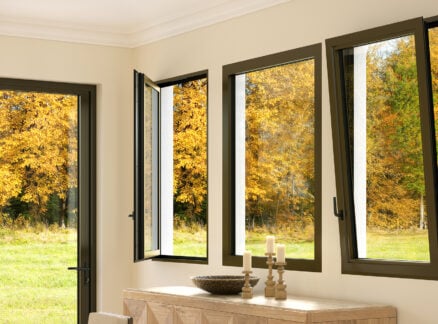March 11, 2013
Q&A:The Head of the Health Product Declaration Collaborative
Look for a slow, steady, reasoned transformation of the marketplace
As head of the Health Product Declaration (HPD) Collaborative, Peter C. Syrett comes to the project with a robust track record that includes his work at Perkins + Will. Five years ago that firm released its Precautionary List, based on nearly a decade of research of potentially toxic materials specified by the architecture and interior design professionals who shape our built environment, inside and outside. Today, Syrett is chairman of the HPD board and has recently launched a new firm, rePlaceUrban Studio, with his partner Philip Palmgren who lead the urban design practice in the New York office of Perkins + Will. “As a practice we aim to build social, ecological, and economic capital in each of our endeavors,” promises Syrett. “We strive to create a healthier urban future;” their new website will be up and running on March 18th. Here he gives some thoughtful answers to questions about what HPD is doing and how it’s going about making our built environment healthier for all who live and work in it.
Susan S. Szenasy: You were part of the group at Perkins + Will that came up with the firm’s Precautionary List of building and furnishings materials known to be dangerous to human health. Can you explain the genesis of that program and what you all hoped would happen as a result of the firm’s free sharing of the information you collected?
Peter C. Syrett: I believe the transformation of the building material market into one that supports human and ecological health will occur in three phases. The first phase is awareness; the Precautionary List is apart of this phase. The Precautionary List grew out of nine years of research on material health. When we released it in 2009 it was intended to be an open resource on substances of concern in building materials, with the intent of provoking action in the design community. We are now in the second phase, which is about the curation and dissemination of information. In this phase awareness continues to grow through greater access to information while the quality of the information and its specificity improves. The HPD is the main tool of this phase. The last phase is innovation. In this phase the market begins to react to the knowledge gained in the earlier two phases. Tools like the HPD will still need to exist in this last stage because we always need a means to get concise information about a product’s content and its associated health issues. That is why the Precautionary List was so important; it got people to look at the built environment in a different way. It is like reading, once you learn to read you can’t look at a word and not read it. My hope is that designers, owners, builders, now look at a material and can’t help think what is in it because of the Precautionary List.
SSS: Now you are chairman of the HPD Board (and working at a new firm). Can you talk about your plans in going forward with HPD and what your goals are? Is there a timeline for action?
PCS: Last fall at GreenBuild we released the first version of the HPD. Until then all our efforts were focused upon creating the HPD and gathering a core group of earlier supporters and enlightened manufacturers for the pilot program. Now that HPD Standard is out we need to quickly build the organizational structure to increase the number of HPDs. We see this as a multi-pronged effort. Foremost, we must increase demand for HPDs. Fortunately, this is already happening. Just last week Cannon Design sent out a letter to manufacturers requesting HPDs “for products used in our buildings be publicly provided” and by January 1, 2015, “only products with product content transparency will be allowed in our library and selected for inclusion on projects.” We will work hard to make sure that Cannon Design’s insistence on HPDs becomes the norm in the building industry. We are also setting up a universal approach for the adoption by rating systems, certifying organizations, purchasing groups, and other parties that wish to use the HPDs as a disclosure standard. This is a complex effort, but is essential to making HPDs a part of standard practice. Most importantly, we are looking at ways to help manufacturers to provide HPDs for their products. Creating a HPD, even for the most basic product, takes a huge amount of effort. Partnering with the manufacturing community is essential for the success of the HPD. To that end, we will be reaching out to members of the manufacturing community that have NOT embraced the use of HPDs to get their input on what we need to do to make the HPD work for them. This will allow us to better refine the HPD for its next update. Ultimately, we hope that use of HPDs exponentially increases in the next few years. We are going to do everything possible to make this a reality.
SSS: There are some 14 hazardous chemicals that I heard of, that seem to crop in many building products. Which are the mostly frequently occurring? Can you list them here and with them, list their known hazards to human health?
PCS: This is a hard question to answer. Since 1957 Chemical Abstract Service (CAS) has given a unique number to every chemical substance that is publically listed in scientific literature, patents, and other open forums. There are now over 70 million substances in the CAS registry, and there are new substances added constantly. (Go to the CAS website, to see the registry counter spinning like a race car’s odometer at the Indy 500). It is estimated that out of those 70 million substances in the CAS registry over 80,000 of them are used daily in commerce. Very few of these substances have been assessed for their impact on human health and the environment – so nobody really knows how many substances in building products that we should be concerned about. That being said, we do know that there are many substances found in building products that have worrisome attributes such as being a Persistent Bio-accumulative and Toxic (PBT) or being a known or suspected reproductive toxicant. For example Phthalates, a type of plasticizer used mostly in the production of flexible Polyvinyl Chloride (PVC) products, will be found in the vast majority of modern buildings. Phthalates are commonly found in plastic: pipes, conduits, waterproofing, roofing, siding, door and windows, resilient flooring, carpet backing, wall covering, signage, window treatments, furniture, and wire cable sheathing. Phthalates are a known carcinogen, developmental toxicant, reproductive toxicant; and is suspected of being an endocrine, gastrointestinal respiratory, and sense organ toxicant. It is incredibly complex topic and this is why the HPD is so important. The HPD allows consumers to see the content of a product along with the associated health information.
SSS: The HPD group is a smart collection business interests involved in the built environment. What is the vision of this coalition for helping to advance the cause of building healthy buildings, inside out?
PCS: The HPD standard is managed by the Health Product Declaration Collaborative. Collaborative being the key word in our name. The HPD has brought together an amazing and diverse group of progressive owners, design firms, non-profit organizations, and manufacturers. Everyone in this group is committed to transforming the building material economy into a transparent marketplace with a multitude of healthy choices. The economic law of supply and demand is how we are working to transform the building industry. Simply put, if there is a market demand for something it will be answered with a supply. Demand for safety changed the auto industry. The demand for organic food changed the food industry. Now consumers are demanding transparency in the building product marketplace. We believe that this demand will make HPDs commonplace in the near future, and will also lead to a wave of innovation – a new generation of products that are healthy for humans and the environment.
SSS: How will HPD Open Standard share its research, findings, and its victories? What should we look for, when and where?
PCS: Since Greenbuild we have gathered a lot of insightful suggestions from the HPD community. For example, the designers are asking where they can find HPDs? This means that we need to create ways for the design community to find HPDs. One suggestion that we are looking at is to provide links to manufacturers that have completed HPDs on our website. We are also looking at ways to tell and celebrate HPD Champions on our website. It would be great to share stories about the positive economic, social, and health impact of the HPD and how the building marketplace is moving towards transparency. In terms of the future, 2013 will be another exciting year for the HPD. See why at our website.
For a manufacturer’s point of view about HPD, click here.
Peter C. Syrett, AIA LEED AP BD+C, is a partner of the newly formed rePlace Urban Studio in New York City, and the chairman of the HPD the board.





